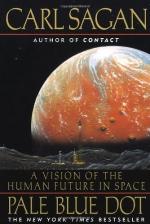
|
| Name: _________________________ | Period: ___________________ |
This test consists of 5 multiple choice questions, 5 short answer questions, and 10 short essay questions.
Multiple Choice Questions
1. What was the name of the second mission that sent probes into the atmosphere of Venus?
(a) Kepler.
(b) Brahe.
(c) Mariner.
(d) Hubble.
2. According to Sagan, what was the major advantage of the attitude of the government towards the Apollo project?
(a) Computers advanced in power rapidly.
(b) Rocket science progressed quickly.
(c) New propulsion systems were developed.
(d) There was plenty of funding for space.
3. Which of the following is NOT one of the missions that observed Venus using radar telescopes?
(a) Vesta.
(b) Venera.
(c) Magellan.
(d) Pioneer.
4. What does Sagan believe about weapons of mass destruction?
(a) They must never used in anger.
(b) They must be destroyed.
(c) They are a necessary evil.
(d) They should be tightly controlled.
5. What was the name of the mission that sent the first probes to Venus?
(a) Lyka.
(b) Sojourner.
(c) Venera.
(d) Oracle.
Short Answer Questions
1. Which of the following characteristics of Venus is LEAST similar to Earth's?
2. What is an astronomical unit?
3. What planet in the solar system obviously suffers from a severe greenhouse gas effect?
4. According to Sagan, how profitable is it for a nation to invest in space exploration?
5. How old are the terrain features generated by Venus' volcanoes?
Short Essay Questions
1. What does Sagan want to see on Mars?
2. What does Sagan think were the major upsides of the Apollo missions?
3. Why does Sagan suggest that space exploration aids in protecting the planet?
4. What does Sagan believe black holes have to offer?
5. What would the process of "terraforming" on Mars be like?
6. Why does Sagan believe it is unlikely that a manned mission to Mars will be carried out in the near future?
7. What types of strategies are most practical for stopping an Earth-bound asteroid?
8. How is Venus different from Earth?
9. What promising signs does Mars have for being host to life?
10. What does Sagan say that it is probably the fate of humanity to "live in the dark"?
|
This section contains 685 words (approx. 3 pages at 300 words per page) |

|




